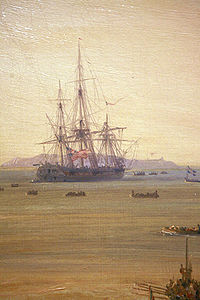HMS Iphigenia (1808)

HMS Iphigenia at the Battle of Grand Port
|
|
| History | |
|---|---|
|
|
|
| Name: | HMS Iphigenia |
| Namesake: | Iphigeneia |
| Laid down: | 1805 |
| Launched: | 26 April 1808 |
| Captured: | at the Battle of Grand Port, late August 1810 |
| Fate: | captured |
|
|
|
| Name: | Iphigénie |
| Acquired: | August 1810 by capture |
| Captured: | December 1810 |
|
|
|
| Name: | HMS Iphigenia |
| Acquired: | December 1810 by capture |
| Fate: | Broken up May 1851 |
| General characteristics | |
| Class and type: | Perseverance-class fifth-rate frigate |
| Tons burthen: | 870, or 876 (bm) |
| Propulsion: | Sail |
| Complement: | 264 |
| Armament: |
|
| Armour: | Timber |
HMS Iphigenia was a Royal Navy 36-gun Perseverance-class fifth-rate frigate. She was built at Chatham Dockyard by Master Shipwright Robert Seppings.
The French captured her at the debacle of Grand Port and in their service she participated in the capture of several British vessels. The British recaptured her and she served in the West Africa squadron (or "Preventative Service"), combating the slave trade. She was broken up in 1851 after serving for many years as a training ship.
Captain Henry Lambert commissioned Iphigenia and sailed her to the Indian Ocean to join the British squadron off Isle de France (now Mauritius). The squadron consisted of Iphigenia, Leopard, Magicienne and Néréide. The squadron blockaded Isle de France from May, and started operations to attempt a take-over on 7 July. Iphigenia was present at the capture of Réunion the next day.
On 10 August, the squadron, under Samuel Pym, landed parties to capture the Île de la Passe and take control of Port-Impérial, initiating the Battle of Grand Port. From 23 August, the British squadron faced off against a French squadron under Guy-Victor Duperré, comprising Minerve, Bellone and Victor. The French had moved the buoys marking the passage through the reef, causing Magicienne and Sirius to run aground and leading the British to scuttle them by fire. Néréide was captured. Iphigenia, which had been kept in reserve, attempted to flee, but French reinforcements under Hamelin - (Vénus, Manche and Créole) - intercepted her, forcing Iphigenia to strike her colours.
...
Wikipedia
